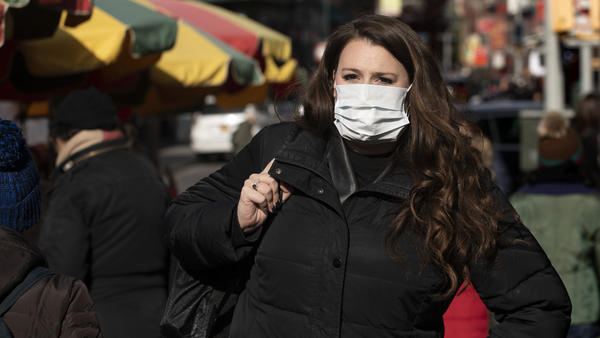U.S. To Americans: 'Do Not Travel To China,' As Coronavirus Infections Surpass SARS
By Bill Chappell • 18 minutes ago

The U.S. safety advisory for China now stands at "Level 4: Do Not Travel," after the WHO declared the Wuhan coronavirus a global health emergency. Here, a woman wears a mask in New York out of concern for the deadly respiratory virus.
Originally published on January 31, 2020 8:07 am
The State Department has issued its most serious travel advisory warning Americans not to visit China, after the World Health Organization declared the Wuhan coronavirus to be a global health emergency. The virus is now confirmed to have spread to at least 22 countries, and more than 200 people have died from the illness in China.
U.S. citizens who are already in China "should consider departing using commercial means," the State Department said Thursday night. The U.S. advisory for China now stands at "Level 4: Do Not Travel" — the same category it uses for hotspots such as Yemen, Libya and South Sudan.
A number of other countries are issuing similar travel warnings to their citizens, although many are focusing on Wuhan's Hubei province rather than the entire Chinese mainland.
On Friday, Singapore announced that all foreign nationals who traveled to China within the past 14 days "will not be allowed entry" or transit through the island nation, which has 16 confirmed coronavirus cases.
Singapore's government also says anyone holding a Chinese passport won't be given a visa to enter the country unless they can prove they haven't recently been to China.
"It is going to hurt us," Singaporean Prime Minister Lee Hsien Loong said Friday. He added that some 3 million Chinese tourists visit Singapore in a normal year.
The number of confirmed coronavirus cases has risen to nearly 10,000 — surpassing the 8,099 cases of SARS that triggered a 2003 outbreak.
In Hong Kong, researchers who study respiratory illnesses say the coronavirus outbreak is only getting started.
Those scientists are saying "this outbreak is just in its early stages, and they expect it to get a lot worse before it gets better," NPR's Jason Beaubien reports. "Chinese officials seem to also feel that way. They're actually building two brand-new hospitals right now in Wuhan, to treat patients from this outbreak. So clearly they think this is going on for a while."
SARS killed at least 744 people — more than three times the current death toll for the coronavirus — and it spread to 32 countries after it was identified in China's Guangdong province. The hardest hit areas other than the mainland were Hong Kong, Singapore and Canada.
In Singapore, Lee says that while the new coronavirus seems to be more infectious than SARS, it has also been less lethal.
"The death rate is much lower, and in China, they are reporting that maybe about 20 per cent of the cases they see become seriously ill," he said, adding that there is no need to panic.
The U.S. warning came hours after the WHO declared the outbreak to be a global health emergency Thursday, putting the novel coronavirus strain — identified as 2019-nCoV – in the same category as the H1N1 flu, zika, polio and Ebola.
The first instance of person-to-person transmission of the coronavirus in the U.S. was confirmed Thursday, the Centers for Disease Control and Prevention said. That case involves spouses: A woman who had traveled to Wuhan spread the virus to her husband when she returned to Chicago, according to the CDC. Both patients are in their 60s and are hospitalized in stable condition, the Illinois Department of Public Health said. It added that the risk to the public remains low.
ijpr.org |





